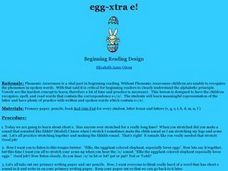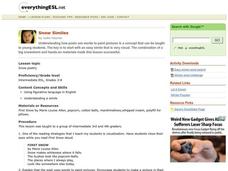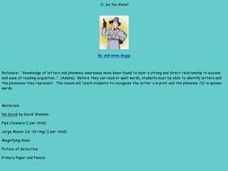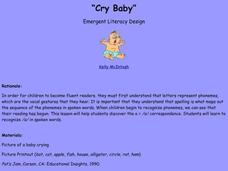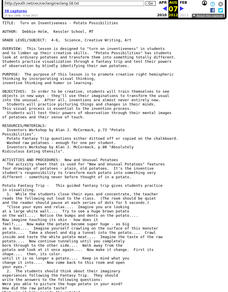Curated OER
Egg-xtra E!
First graders recognize the short vowel e in written and spoken language. Through listening activities, they discriminate the vowel sound /e/ from other phonemes. Students identify the phoneme and letter in words and sentences they write.
Curated OER
The Baby is Crying
Students identify the short /a/ sound in written and spoken words. They say a tongue twister which contains words emphasizing the short /a/ sound. They then listen to "A Cat Nap" and raise their hand every time they hear a word...
Curated OER
Silly Snake
Students practice recognizing and sounding out the letter S. They listen to the alphabet song, "Sea Shell," by Amy Lowell, and view a large picture of a snake in the shape of the letter S. Each student points out other objects found in...
Curated OER
Family Tradition And History
Second graders investigate personal family traditions with objects brought to class that represent personal history. The objects are shared with the class during sharing time. The goal of the lesson is that students would recognize there...
Curated OER
The First Day
Students explore the inauguration of George W. Bush, examine historical precedents, and devise inaugural proceedings for a person of their own choosing.
Curated OER
You Can Judge a Book by Its Cover
Sixth graders discover that the cover of printed material holds clues to its content.
Curated OER
Snow Similes
Students see how poets use words to paint pictures. The combination of a big snowstorm and hands-on materials make this lesson successful. There are some nice attachments that the students will really enjoy!
Curated OER
DOES A FLUCTUATION IN TEMPERATURE IFFECT THE GROWTH AND SURVIVAL RATE OF AQUATIC PLANTS?
Students determine if different temperatures effect the growth and survival rates of aquatic plants and evaluate the optimal temperature for the growth of aquatic plants.
Curated OER
Heritage: Legends, Fairy Tales and the Native Americans
Fourth graders compare and contrast a Native American legend with a fairy tale and share their ideas by creating a venn diagram.
Curated OER
Creating Pinhole Prints
Ninth graders produce an image from a negative created with a pinhole camera using the provided materials and create a test strip in 5 second increments to determine the exposure time for a final print.
Curated OER
TV Without the Television
Pupils consider their own understanding of advertising on the Internet and examine the latest form of advertising online to create "How it Works" posters for a variety of Internet technologies. They reflect on how these technologies have...
Curated OER
Meeting in a Fishbowl: Consensus vs. Democracy
High schoolers analyze the democratic and consensual decision-making process. They review the distinctions between decision-making and consensus and simulate a town meeting and a tribal meeting. They select an issue and research the...
Curated OER
O, Do You Know?
Students identify the short /o/ sound in this lesson. They discover that the "o" is shaped like a magnifying glass, and are "detectives" looking for the /o/ sound in words. They listen to "No, David!" and identify the short /o/ sound...
Curated OER
Cry Baby
Students recognize the short vowel a in written and spoken language. Through matching and listening activities, they discriminate the vowel sound /a/ from other phonemes. Students associate the phoneme with its letter representation...
Curated OER
The Not-So-Scary Creaky Door!
Students recognize the short vowel e in spoken language. Through listening activities, they discriminate the short vowel phoneme /e/ from other phonemes. Students associate the phoneme with its letter representation and identify the...
Curated OER
"Uuuuuuggghhh That Hurts"
First graders give examples of consonants and vowels. They review the sound the /u/ phoneme makes and then play a word creation game placing letters together to make the /kuuuu/ sound which bumps into /p/ forming the word "cup" as a class.
Curated OER
Civil War Documents In Brooklyn
Young scholars investigate the use of monuments and why they are important for the study of history. They conduct research using a collection of primary sources. Students write a report about the information they find and present it to...
Pennsylvania Department of Education
Stories? Information? What's the Difference?
Students listen to a power point presentation to distinguish between fiction and nonfiction text. In this what's the difference lesson, students identify fact from opinion within a text. Students listen critically and respond to text.
Curated OER
Turn on Inventiveness
Learners practice visualization through a fantasy trip and test their powers of observation by blindly identifying their own potatoes.
Curated OER
An Ounce of Prevention...
Students discuss current H.I.V. prevention strategies and adapt these strategies to address the spread of H.I.V. in developing countries. They analyze the results of an international AIDS conference called "The Urgent Search for an AIDS...
Curated OER
Hunting and Gathering in the African Rain Forest
Students demonstrate their knowledge of the Mbuti people hunting and gathering in the African rain forest by writing a story about a Mbuti hunting or gathering food.
Curated OER
Words, Words, Words
Second graders choose estimation strategies in real-world problem situations and explain the choice. They work in groups of five using three different estimation methods to find out how many words are on a page of text.
Curated OER
Let's Make Lemonade Lesson 1: What is a Philanthropist?
Students define the words philanthropists and philanthropy. They make flip books representing the story, The Lion and the Mouse and retell the story to a classmate.
Curated OER
Eggs, Experiment Lab, Day 3
Third graders complete a lab activity preparing scrambled eggs.


